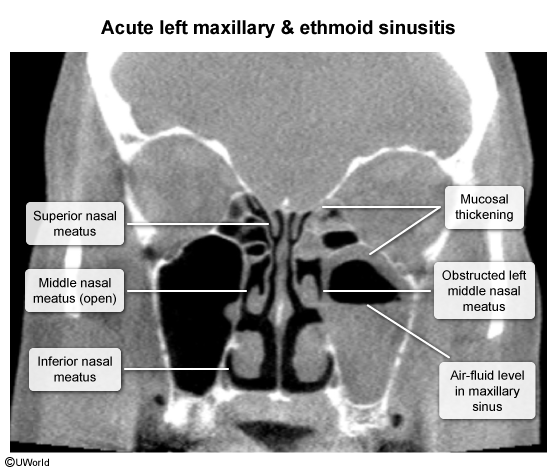- Definition & Etiology
- Inflammation of the paranasal sinuses, almost always involving the nasal mucosa (hence, “rhinosinusitis”).
- Acute (<4 weeks): Most commonly viral (e.g., Rhinovirus, Influenza), often following a URI. A small percentage (0.5-2%) develop a secondary bacterial infection.
- Acute Bacterial Pathogens: Most common are Streptococcus pneumoniae, Haemophilus influenzae (non-typeable), and Moraxella catarrhalis.
- Chronic (>12 weeks): Often involves S. aureus, anaerobes, and gram-negative bacteria. Fungal causes (e.g., Aspergillus, Mucor) are significant in immunocompromised patients (e.g., diabetics, neutropenic).
- Pathophysiology: Sinus ostia obstruction → impaired mucociliary clearance → mucus retention and microbial growth.
- Site
- Most common: Maxillary sinuses.
- Pathophysiology: The maxillary sinus is the largest of the paranasal sinuses. Its drainage ostium is located superiorly and medially, which leads to inefficient, gravity-dependent drainage. This predisposition to stasis makes it the most susceptible to infection.
- Clinical Presentation
- Symptoms: Nasal congestion, purulent (yellow-green) nasal discharge, facial pain/pressure (worse on bending forward), maxillary toothache, fever, and cough.
- Differentiating Viral vs. Bacterial:
- Viral: Symptoms typically last <10 days and are self-improving.
- Bacterial: Suspect if symptoms persist >10 days without improvement, are severe from onset (fever ≥39°C/102.2°F + purulent discharge >3 days), or show a “double-sickening” course (worsening after initial improvement).
- Viral turns to bacterial: Symptoms typically remain stable or improve for 5–6 days and then worsen (double worsening).
- Diagnosis
- Primarily clinical: Based on the duration and pattern of symptoms.
- Physical Exam: Tenderness to palpation over sinuses, purulent drainage in the nasal cavity.
- Imaging: Not recommended for uncomplicated acute sinusitis. A CT scan is the test of choice if complications (e.g., orbital, intracranial) are suspected or for chronic sinusitis evaluation.

- Differential Diagnostics
- Allergic Rhinitis: Associated with clear rhinorrhea, sneezing, itchy/watery eyes, and pale/boggy nasal mucosa.
- Migraine/Tension Headache: Lacks purulent discharge and fever.
- Dental Abscess: Can cause maxillary pain and focal swelling.
- Management
- Viral / Symptomatic Tx:
- Analgesics (NSAIDs, acetaminophen).
- Saline nasal irrigation and intranasal corticosteroids (e.g., fluticasone) can relieve congestion and facial pain.
- Decongestants (oral or topical) for short-term use (<3-5 days) to avoid rebound congestion.
- Bacterial Tx:
- First-line antibiotic: Amoxicillin with or without clavulanate.
- Indicated only if criteria for bacterial sinusitis are met (persistent, severe, or worsening course).
- Macrolides and fluoroquinolones are generally discouraged due to resistance and adverse effects.
- Key Associations & Complications
- Complications are rare but serious and occur via direct extension of infection.
- Orbital Cellulitis: Proptosis, pain with eye movements, vision changes. Most common complication, especially from ethmoid sinusitis.
- Intracranial Extension: Can lead to meningitis, epidural abscess, or cavernous sinus thrombosis. Suspect with severe headache, fever, vision changes, or altered mental status.
- Pott’s Puffy Tumor: Osteomyelitis of the frontal bone, presenting as a tender, doughy forehead swelling.
- Invasive Fungal Sinusitis: A medical emergency in immunocompromised patients (especially DKA), often caused by Mucor or Aspergillus. Look for necrotic eschars in the nasal cavity.
